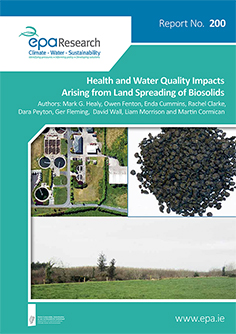Research 200: Health and Water Quality Impacts Arising from Land Spreading of Biosolids
Authors: Mark G. Healy, Owen Fenton, Enda Cummins, Rachel Clarke, Dara Peyton, Ger Fleming, David Wall, Liam Morrison and Martin Cormican
Summary: Research Report 200 detailing the Health and Water Quality Impacts Arising from Land Spreading of Biosolids

The aims of this study were to: (1) undertake a thorough literature review of the spreading of treated sewage sludge (biosolids) on land to include analysis of potential impacts on environmental and human health; (2) examine, under controlled conditions in the laboratory and field, the impact of the landspreading of biosolids (on grassland) on surface runoff/subsurface drainage/shallow groundwater of nutrients, solids, metals, pathogens and some specified emerging contaminants identified in the literature review, when spread based on N and P application rates; and (3) to model and conduct a risk assessment of potential hazards of human health concern.
Identifying Risks
Implementation of European Union Directives in recent decades concerning the collection, treatment and discharge of wastewater, as well as technological advances in the upgrading and development of wastewater treatment plants, has resulted in an increase in the number of households connected to sewers and an increase in the production of sewage sludge (the by-product of wastewater treatment plants). Recycling to land is currently considered the most economical and beneficial way for municipal sewage sludge management. However, despite the many potential benefits of recycling municipal sewage sludge to land, there are many risks, which include the presence of emerging contaminants in the sewage sludge that may enter the food chain, and the potential for surface runoff of contaminants into receiving waters. This project found that although the application of biosolids poses no greater threat to surface water quality than the land application of dairy cattle slurry, there is a possibility that many non-priority elements and emerging contaminants, for which no legislation currently exists, may be applied to land without regulation, and may accumulate in the soils and enter the food chain.
Informing Policy
Current legislation governing the land application of municipal sewage sludge to land considers certain priority pollutants and bio-essential elements. However, other emerging contaminants may be inadvertently applied to land. Regulations should be extended to cover non-priority elements, pharmaceuticals and personal care products (PPCPs). Non-priority elements are relatively inexpensive to measure, but PPCPs are prohibitively expensive as well as being continuously evolving. Wastewater treatment plants may be upgraded to include treatment of emerging contaminants, but the potential presence of known, as well as currently unknown parameters, raises concerns over the continued application of biosolids to land in Ireland.
https://www.epa.ie/media/epa-2020/publications/research/EPA-RR-200_web_20mm[1].jpg